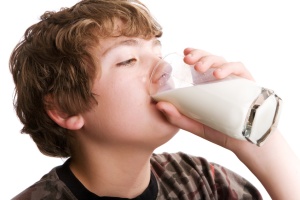There are three main reasons mainstream health professionals say human beings should drink a lot of milk. The first is to get enough Vitamin D, the second is to get enough Vitamin A and the third is to get enough calcium. Interestingly enough, dairy is not really a great source of any of these nutrients, and ingesting it can come with a whole slew of issues.
What is the Matter with the Moo Juice?
When shopping for food in the grocery store, it is important to make note of certain marketing terms. One such term is “fortified.” When a food product is “fortified” with any given nutrient, the food usually does not have a lot of that thing in it to begin with. Milk is one such item. In its natural pre-pasteurized state, it contains only trace amounts of Vitamin D. A serving of whole variety has approximately 9 percent of the recommended daily amount of Vitamin A for an adult. However, the reduced fat varieties contain even less Vitamin A.
 Calcium is the third matter. Most pasteurized varieties contain quite a bit of calcium. The amount is usually around 300 micrograms per cup. That is a good amount of calcium, but it comes with two problems. The first is that the body needs magnesium with the calcium to digest it, and there is not usually enough magnesium to help with that process. The second problem is that some studies have shown that this supposedly healthy liquid actually leeches calcium from the bones! That completely negates one of the main reasons for drinking it in the first place.
Calcium is the third matter. Most pasteurized varieties contain quite a bit of calcium. The amount is usually around 300 micrograms per cup. That is a good amount of calcium, but it comes with two problems. The first is that the body needs magnesium with the calcium to digest it, and there is not usually enough magnesium to help with that process. The second problem is that some studies have shown that this supposedly healthy liquid actually leeches calcium from the bones! That completely negates one of the main reasons for drinking it in the first place.
Finally, for those who are trying to avoid casein for various reasons, including autism related issues to simply seeing if it is one of the sources of digestive distress, the drink contains quite a bit of casein. There are generally six proteins in each variety of cow’s milk. Of those six, four are casein. That makes it terrible for a GFCF diet.
What are the Milk Alternatives?
Dairy is great for certain recipes, with cold cereals and a number of other foods. However, because of its issues, it is often better to entertain the idea of using milk alternatives. These are made out of several non-dairy foods, but the most common milk alternatives are:
- Almond
- Coconut
- Rice
- Soy
Two of the better types for baking and overall natural flavor are the almond and coconut varieties. Most of these are interchangeable in every application with regular dairy. Each variety makes great ice cream and, in the case of soy, a reasonable alternative to traditional cheese. These are just a few of the ways to avoid moo juice while still enjoying the same recipes.




Leave a comment
Comments feed for this article